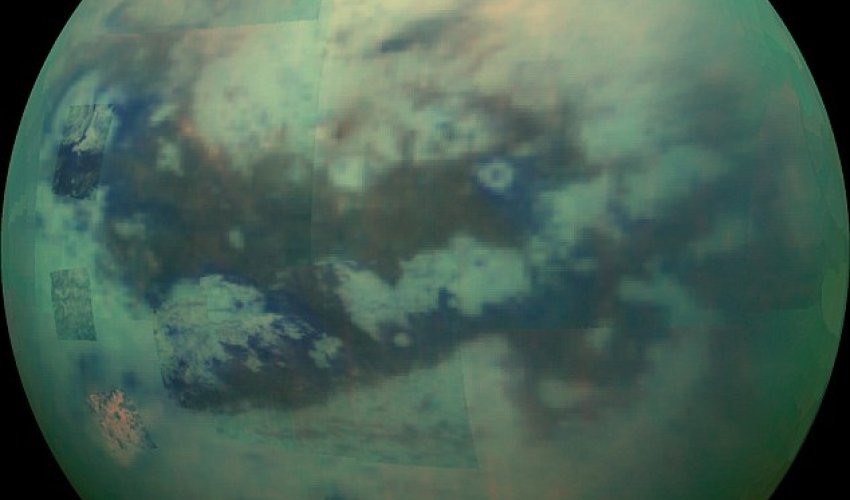Is this haze hiding alien life?

It is one our best ever glimpses of the haze of 'Earth's evil twin', and a tantalising view of Saturn's moon, which many believe could harbour alien life.
Nasa's Cassini spacecraft, acquired during the mission's 'T-114' flyby on Nov. 13, 2015, passing 6,200 miles (10,000 kilometers) above.
It shows the parallel, dark, dune-filled regions named Fensal (to the north) and Aztlan (to the south), which form the shape of a sideways letter 'H.'
The composite image shows an infrared view of Saturn's moon Titan.
The spacecraft's visual and infrared mapping spectrometer (VIMS) instrument made these observations, in which blue represents wavelengths centered at 1.3 microns, green represents 2.0 microns, and red represents 5.0 microns.
A view at visible wavelengths (centered around 0.5 microns) would show only Titan's hazy atmosphere (as in PIA14909).
The near-infrared wavelengths in this image allow Cassini's vision to penetrate the haze and reveal the moon's surface.
Several places on the image show the surface at higher resolution than elsewhere.
'These areas, called subframes, show more detail because they were acquired near closest approach,' said Nasa.
Near the limb at left, above center, is the best VIMS view so far of Titan's largest confirmed impact crater, Menrva (first seen by the RADAR instrument inPIA07365).
Similarly detailed subframes show eastern Xanadu, the basin Hotei Regio, and channels within bright terrains east of Xanadu.
During this Titan flyby, the spacecraft's closest-approach altitude was 6,200 miles (10,000 kilometers), which is considerably higher than those of typical flybys, which are around 750 miles (1,200 kilometers).
The high flyby allowed VIMS to gather moderate-resolution views over wide areas (typically at a few kilometers per pixel).
The view looks toward terrain that is mostly on the Saturn-facing hemisphere of Titan.
The scene features the parallel, dark, dune-filled regions named Fensal (to the north) and Aztlan (to the south), which form the shape of a sideways letter 'H.'
Earlier in the year Cassini probe recently spotted the monstrous ice cloud in the moon's low- to mid-stratosphere.
The probe had already imaged an impressive cloud hovering over Titan's south pole at an altitude of about 186 miles (300km) – but that was just the tip of the iceberg.
The latest ice cloud system is far bigger, and has now been found below this cloud, peaking at an altitude of about 124 miles (200km).
Carrie Anderson, the lead researcher for this work told DailyMail.com that the new cloud spans about 5 degrees in latitude (from about 75 degrees south to 80 degrees south).
Five degrees in latitude corresponds to about 150 miles (240km) across.
The new cloud was detected by Cassini's infrared instrument – the Composite Infrared Spectrometer, or CIRS.
It's believed to have a low density, similar to Earth's fog but likely flat on top.
For the past few years, Cassini has been catching glimpses of the transition from fall to winter at Titan's south pole – the first time any spacecraft has seen the onset of a Titan winter.
Because each Titan season lasts about seven and a half years on Earth's calendar, the south pole will still be enveloped in winter when the Cassini mission ends in 2017.
'When we looked at the infrared data, this ice cloud stood out like nothing we've ever seen before,' said Carrie Anderson of Nasa's Goddard Space Flight Center. 'It practically smacked us in the face.'
(dailymail.co.uk)
www.ann.az




































 Photo
Photo 



 Video
Video 

